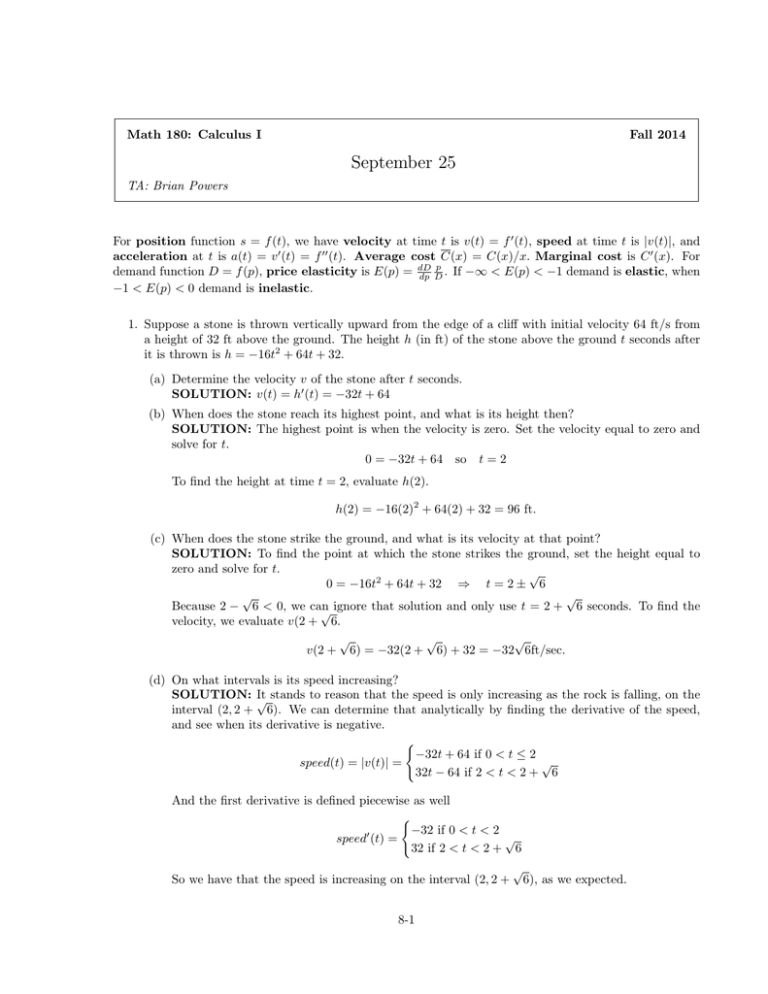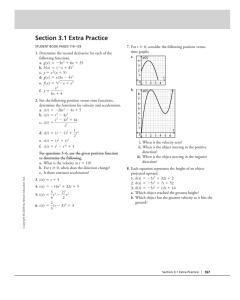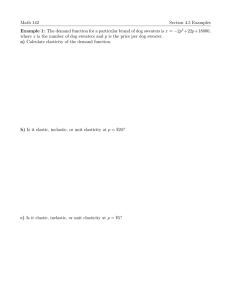Solutions
advertisement

Math 180: Calculus I Fall 2014 September 25 TA: Brian Powers For position function s = f (t), we have velocity at time t is v(t) = f 0 (t), speed at time t is |v(t)|, and acceleration at t is a(t) = v 0 (t) = f 00 (t). Average cost C(x) = C(x)/x. Marginal cost is C 0 (x). For p demand function D = f (p), price elasticity is E(p) = dD dp D . If −∞ < E(p) < −1 demand is elastic, when −1 < E(p) < 0 demand is inelastic. 1. Suppose a stone is thrown vertically upward from the edge of a cliff with initial velocity 64 ft/s from a height of 32 ft above the ground. The height h (in ft) of the stone above the ground t seconds after it is thrown is h = −16t2 + 64t + 32. (a) Determine the velocity v of the stone after t seconds. SOLUTION: v(t) = h0 (t) = −32t + 64 (b) When does the stone reach its highest point, and what is its height then? SOLUTION: The highest point is when the velocity is zero. Set the velocity equal to zero and solve for t. 0 = −32t + 64 so t = 2 To find the height at time t = 2, evaluate h(2). h(2) = −16(2)2 + 64(2) + 32 = 96 ft. (c) When does the stone strike the ground, and what is its velocity at that point? SOLUTION: To find the point at which the stone strikes the ground, set the height equal to zero and solve for t. √ 0 = −16t2 + 64t + 32 ⇒ t = 2 ± 6 √ √ Because 2 − 6 < 0, we can √ ignore that solution and only use t = 2 + 6 seconds. To find the velocity, we evaluate v(2 + 6. √ √ √ v(2 + 6) = −32(2 + 6) + 32 = −32 6ft/sec. (d) On what intervals is its speed increasing? SOLUTION: √ It stands to reason that the speed is only increasing as the rock is falling, on the interval (2, 2 + 6). We can determine that analytically by finding the derivative of the speed, and see when its derivative is negative. ( −32t + 64 if 0 < t ≤ 2 √ speed(t) = |v(t)| = 32t − 64 if 2 < t < 2 + 6 And the first derivative is defined piecewise as well ( −32 if 0 < t < 2 0 √ speed (t) = 32 if 2 < t < 2 + 6 So we have that the speed is increasing on the interval (2, 2 + 8-1 √ 6), as we expected. 8-2 TA Discussion 8: September 25 2. For the following (i) find the average cost and marginal cost functions, (ii) Determine the average and marginal cost when x = a, and interpret these values (a) C(x) = 1000 + 0.1x, 0 ≤ x ≤ 5000; a = 2000 SOLUTION: C(x) 1000 C̄(x) = = + 0.01, x x C 0 (x) = 0.1 So C̄(a) = C̄(2000) = 1000/2000 + .01 = .51, C 0 (a) = C 0 (2000) = 0.01. This means that when the quantity produced is 2000, it costs $0.51 per item, and the cost to produce one more item is $0.01. (b) C(x) = −0.01x2 + 40x + 100, 0 ≤ x ≤ 1500; a = 1000 SOLUTION: C̄(x) = 100 C(x) = −0.01x + 40 + , x x C 0 (x) = −0.02x + 40 So C̄(a) = C̄(1000) = −0.01(1000)+40+100/(1000) = 30.1 and C 0 (a) = C 0 (1000) = −0.02(1000)+ 40 = 20. This means that when the quantity produced is 1000, it costs $30.1 per item, and the cost to produce one more item is $20.00. 3. Compute the elasticity for the exponential demand function D(p) = ae−bp , where a and b are positive real numbers. For what prices is the demand elastic? Inelastic? p SOLUTION: Elasticity E(p) = dD dp D sp E(p) = (−bae−bp ) p = −bp ae−bp So the price is elastic as long as −bp < −1, which is the same as p > 1b . It is inelastic if −1 < −bp < 0 or 0 < p < 1b . 4. Show that the demand function D(p) = a/pb , where a and b are positive real numbers, has a constant elasticity for all positive prices. SOLUTION: Again, we calculate elasticity, re-writing D(p) = ap−b , E(p) = (−bap−b−1 ) p −bap−b = = −b ap−b ap−b So the elasticity is constant, irrespective of the price p.





